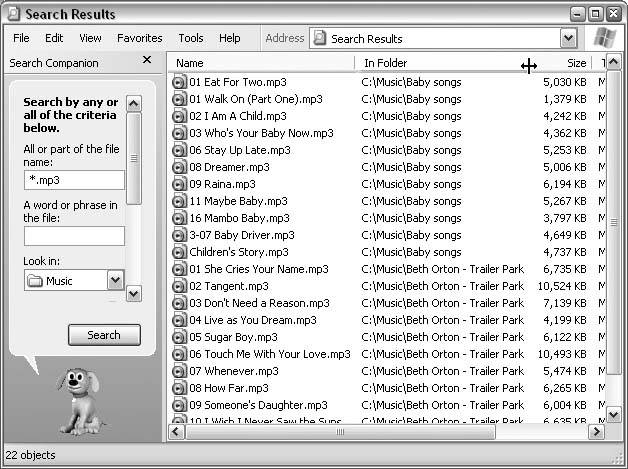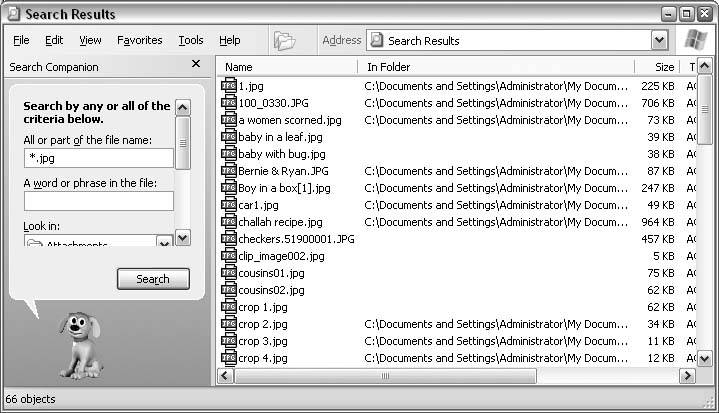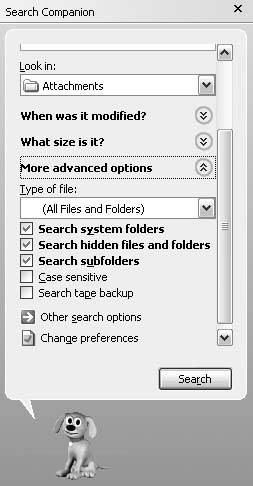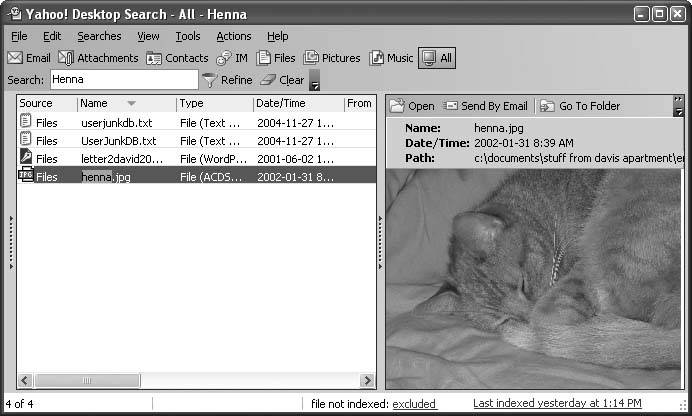Section 2.4. SEARCHING
2.4.1. Search in a New WindowTHE ANNOYANCE: When I'm viewing a folder in Windows Explorer and I press Ctrl-F or F3 to search for something in that folder, the folder tree is replaced with a Search pane (see Figure 2-18). I want my tree back! THE FIX: There are a bunch of ways to get to the Search tool in Windows, but few are as convenient as starting a search based in the current folder with Ctrl-F. Of course, it's decidedly inconvenient when you lose your current view every time you start a search this way. And what's worse is that there's no way to get the folder tree back without a lot of clicking (pressing Ctrl-F again doesn't do it); you have to go to View The workaround is to open Search in a new window by right-clicking a folder in Windows Explorer and selecting Search; it's not as quick as Ctrl-F or F3, but it does the trick. To force Windows Explorer to open a new window every time you press Ctrl-F or F3, you'll need Creative Element Power Tools, available at http://www.creativelement.com/powertools/. Once you've installed the software, open the Creative Element Power Tools Control Panel and turn on the "Fix the Windows Search tool" option. Figure 2-18. Start a search, and the folder tree disappears!
2.4.2. Jump to Advanced SearchTHE ANNOYANCE: Every time I open the Search tool, I'm asked "What do you want to search for?" and then I have to pick from a list. Is my Photoshop file a "picture" or is it a "document"? These unnecessary steps drive me crazy. How can I go right to the Search window? THE FIX: To skip this menu in the future and go straight to the "All files and folders" Search tool (see Figure 2-19), return to the "What do you want to search for?" page and click "Change preferences." Click "Change files and folders search behavior," and select Advanced. Explorer will remember your preference, and you won't have to deal with the menu again unless you want to. Figure 2-19. Change your preferences so you don't have to jump through hoops to get to the actual Search tool in Windows XP.
2.4.3. Take the Dog for a WalkTHE ANNOYANCE: The dog was cute at first, but it's always making scratching sounds while I'm trying to work. How do I keep him quiet? THE FIX: You can't turn off the sounds, but you can turn off the dog. In the main Search window, click Change Preferences, then click "Without an animated character." You can also click "With a different character" to choose between Rover (the puppy), Merlin (a wizard), Earl (a surfboarding banana), or Courtney (anybody's guess). 2.4.4. See the Whole MegillahTHE ANNOYANCE: When I perform a search, I have a hard time making out the full filenames or complete folder names in the search results. THE FIX: The columns in Explorer's Search Results are too small by default (see Figure 2-20). Start by enlarging the window horizontally. Then, drag the column dividers with your mouse to enlarge the Name and In Folder columns, as shown in Figure 2-21. Alternatively, you can double-click the column dividersthis will automatically resize the columns to accommodate their contents. Figure 2-20. You can't see anything in this tiny window.
Windows Explorer should remember your column preferences for future visits to the Search window, but it doesn't always get it right and sometimes inserts unwanted columns (such as the pointless Relevance column) or reverts to the default layout. Unfortunately, there's no way to definitively save your favorite Search window layout, as you can in the main Explorer window (see "Get the Details View Every Time"), so you may have to reassert your preferences from time to time. Figure 2-21. Much better!
2.4.5. Reveal Missing Paths in Search ResultsTHE ANNOYANCE: I'm looking at a list of search results, and some of the folder names (shown in the "In Folder" column) are missing or incomplete, like in Figure 2-22. How do I find out where these files are located? Figure 2-22. Where are these files located?
THE FIX: Those folder names are missing because the files are located inside ZIP files, which Windows XP searches along with ordinary folders. (See the "What Are ZIP Files?" sidebar for details.) Alas, there's a bug in the Search toolthe In Folder column is left blank for any file found inside a ZIP file. The only way to find the location and name of one of these ZIP files is to select File If you want to avoid this problem altogether, you must disable Windows XP's built-in support for ZIP files. To do this, go to Start regsvr32 /u %windir%\system32\zipfldr.dll
Click OK when you're done, and the change will take effect immediately. Of course, this fix has its consequences. For one, Search will no longer look inside ZIP files, so files contained only within them won't turn up in your search resultsit will complete searches more quickly, but its results may leave out certain items. Also, Windows will no longer be able to open or create ZIP files. If you can't live without built-in ZIP support, go back to Start regsvr32 %windir%\system32\zipfldr.dll
Better yet, leave Windows's ZIP support disabled and instead download a third-party ZIP utility such as WinZip ($29.95, http://www.winzip.com). 2.4.6. Find Recent FilesTHE ANNOYANCE: The Documents menu in the Start menu shows only some of the documents I've worked on recently. How do I get a complete listing of recently modified files? THE FIX: The Recent Documents folder contains shortcuts to files you've double-clicked in Windows Explorer, as well as documents you've opened and saved in certain applications, and the last dozen of these are shown in your Documents menu. But, for whatever reason, not all programs support this feature. Fortunately, you can find all recent files with a quick search. Go to Start 2.4.7. Save Your SearchesTHE ANNOYANCE: I need to run the same searches over and over. Is there a way to quickly repeat past searches? THE FIX: Once you've performed a search, or at least started one, you can save your settings in a file. In the Search Results window, select File 2.4.8. Save Your Search ResultsTHE ANNOYANCE: Okay, I saved my search, but when I close the Search window and then double-click the file, all my previous search results are gone. What happened? THE FIX: The Save Search feature doesn't save search results; it only saves the search parameters, such as the folder path that's being searched, the text to search for, the date range (if you specified one), and other options. Although Windows has no way of creating a permanent record of search results, you can do this with the "Copy file and folder names to the Clipboard" tool in Creative Element Power Tools (http://www.creativelement.com/powertools/). After completing a search, press Ctrl-A to highlight all the files in the Search Results window, right-click, and select Copy Filename. Open any plain-text editor (such as Notepad), press Ctrl-V to paste in your results, and save the file listing. 2.4.9. Find a File Where Search Doesn't LookTHE ANNOYANCE: I've been searching for a file for weeks. I don't think I deleted it, but I can't find it anywhere. Why can't the Search tool find it? THE FIX: When you search, you're not necessarily looking in every nook and cranny of your hard disk. For starters, Search only looks in the folder specified in the drop-down "Look in" list, so you'll want to select Local Hard Drives to broaden your search. Next, click "More advanced options," and place checkmarks next to the first three options shown in Figure 2-23. It's also possible that Windows isn't configured to show you all of your files. In the Search Results window, go to Tools Figure 2-23. Turn on these options to look in more places.
Note: Of course, it's possible your file has found its way into one of the four folders in which Search will never look: the Recycle Bin (c:\Recycler), the Fonts folder (c:\Windows\Fonts), the System Restore archive folder (c:\System Volume Information), or the Nethood folder (c:\Documents and Settings\{user}\ NetHood). To see all the files stored in these special folders, open a Command Prompt window (go to Start  Run and type cmd.exe) and use the CD and DIR commands to enter each folder and view its contents, respectively. Run and type cmd.exe) and use the CD and DIR commands to enter each folder and view its contents, respectively.2.4.10. Search Inside FilesTHE ANNOYANCE: I tried searching for files containing some text by typing the text into the "A word or phrase in the file" box, but I didn't get any results. I tried again with text I knew was in one of the files, but I still got nothing! THE FIX: You're not doing anything wrong; sometimes, this feature simply doesn't work. If you want to find files based on their contents, you'll need to use a different program. Check out one of the free third-party desktop search applications described in "Faster Searches," next. 2.4.11. Faster SearchesTHE ANNOYANCE: It takes forever for Windows to conduct a simple search. How can I speed things up? THE FIX: Windows has a little-known feature called the Indexing Service that can marginally speed up searches. To enable indexing, open a Search window, click "Change preferences" then "With Indexing Service," and choose Yes. At this point, Windows begins cataloging your files whenever your PC isn't being used, so that (eventually) Windows can merely consult the catalog instead of physically searching through all your folders and files. However, Windows's rudimentary indexing service is no match for some third-party desktop search tools, which rely on their own brand of indexing to serve up search results in a jiffy. Probably the first such tool that comes to mind is Google Desktop Search (free, http://desktop.google.com), but its awkward web-based interface and scant file type support make it a poor choice. Instead, try Yahoo Desktop Search (free, http://desktop.yahoo.com), which offers an interface more similar to Windows Explorer's and includes support for hundreds of file types (see Figure 2-24). Figure 2-24. Use a third-party desktop search tool to find files faster.
Other free choices include Copernic Desktop Search (http://www.copernic.com) and MSN Search Toolbar with Windows Desktop Search (http://toolbar.msn.com). If you're serious about searching, check out the reviews at http://www.searchenginewatch.com. |







